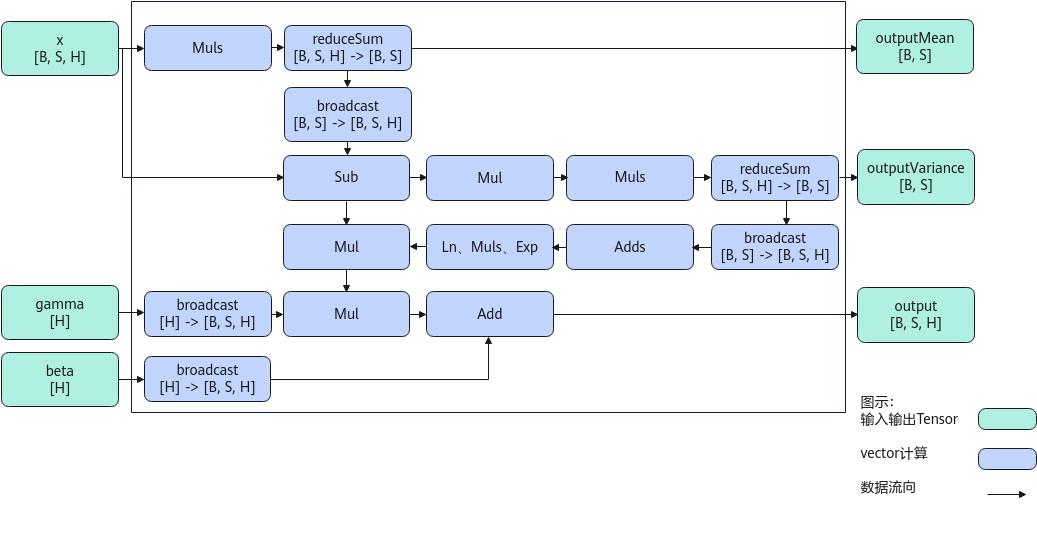LayerNorm
函数功能
在深层神经网络训练过程中,前面层训练参数的更新,会引起后面层输入数据分布的变化,导致权重更新不均衡及学习效率变慢。通过采用归一化策略,将网络层输入数据收敛到[0, 1]之间,可以规范网络层输入输出数据分布,加速训练参数收敛过程,使学习效率提升更加稳定。LayerNorm是许多归一化方法中的一种。
本接口实现了对shape大小为[B,S,H]输入数据的LayerNorm归一化,其计算公式如下,其中γ为缩放系数,β为平移系数,ε为防除零的权重系数:

其中,如下两个参数分别代表输入在H轴的均值和方差。

实现原理
以float类型,ND格式,输入为inputX[B, S, H],gamma[H]和beta[H]为例,描述LayerNorm高阶API内部算法框图,如下图所示。

计算过程分为如下几步,均在Vector上进行:
- 计算均值:Muls计算x*1/m的值,再计算累加值ReduceSum,得到均值outputMean;
- 计算方差:Sub计算出输入x与均值的差值,再用Mul进行平方计算,最后用Muls乘上1/m并计算累加值,得到方差outputVariance;
- 处理gamma和beta:通过broadcast得到BSH维度的gamma和beta;
- 计算输出:方差通过broadcast得到BSH维度的tensor,再依次经过Adds(outputVariance, eps), Ln, Muls, Exp,最后与(x-均值)相乘,得到的结果乘上gamma,加上beta,得到输出结果。
函数原型
由于该接口的内部实现中涉及复杂的计算,需要额外的临时空间来存储计算过程中的中间变量。临时空间大小BufferSize的获取方法:通过LayerNorm Tiling中提供的GetLayerNormMaxMinTmpSize接口获取所需最大和最小临时空间大小,最小空间可以保证功能正确,最大空间用于提升性能。
临时空间支持接口框架申请和开发者通过sharedTmpBuffer入参传入两种方式,因此LayerNorm接口的函数原型有两种:
- 通过sharedTmpBuffer入参传入临时空间
1 2
template <typename T, bool isReuseSource = false> __aicore__ inline void LayerNorm(const LocalTensor<T>& output, const LocalTensor<T>& outputMean, const LocalTensor<T>& outputVariance, const LocalTensor<T>& inputX, const LocalTensor<T>& gamma, const LocalTensor<T>& beta, const LocalTensor<uint8_t>& sharedTmpBuffer, const T epsilon, LayerNormTiling& tiling)
该方式下开发者需自行申请并管理临时内存空间并管理,并在接口调用完成后,复用该部分内存,内存不会反复申请释放,灵活性较高,内存利用率也较高。
- 接口框架申请临时空间
1 2
template <typename T, bool isReuseSource = false> __aicore__ inline void LayerNorm(const LocalTensor<T>& output, const LocalTensor<T>& outputMean, const LocalTensor<T>& outputVariance, const LocalTensor<T>& inputX, const LocalTensor<T>& gamma, const LocalTensor<T>& beta, const T epsilon, LayerNormTiling& tiling)
该方式下开发者无需申请,但是需要预留临时空间的大小。
参数说明
参数名 |
描述 |
|---|---|
T |
操作数的数据类型。 |
isReuseSource |
是否允许修改源操作数,默认值为false。如果开发者允许源操作数被改写,可以使能该参数,使能后能够节省部分内存空间。 设置为true,则本接口内部计算时复用inputX的内存空间,节省内存空间;设置为false,则本接口内部计算时不复用inputX的内存空间。 对于float数据类型输入支持开启该参数,half数据类型输入不支持开启该参数。 isReuseSource的使用样例请参考更多样例。 |
参数名称 |
输入/输出 |
含义 |
|---|---|---|
output |
输出 |
目的操作数,类型为LocalTensor,shape为[B, S, H],LocalTensor数据结构的定义请参考LocalTensor。 Atlas A2训练系列产品/Atlas 800I A2推理产品,支持的数据类型为:half/float Atlas推理系列产品AI Core,支持的数据类型为:half/float |
outputMean |
输出 |
均值,类型为LocalTensor,shape为[B, S],LocalTensor数据结构的定义请参考LocalTensor。 Atlas A2训练系列产品/Atlas 800I A2推理产品,支持的数据类型为:half/float Atlas推理系列产品AI Core,支持的数据类型为:half/float |
outputVariance |
输出 |
方差,类型为LocalTensor,shape为[B, S],LocalTensor数据结构的定义请参考LocalTensor。 Atlas A2训练系列产品/Atlas 800I A2推理产品,支持的数据类型为:half/float Atlas推理系列产品AI Core,支持的数据类型为:half/float |
inputX |
输入 |
源操作数,类型为LocalTensor,shape为[B, S, H],LocalTensor数据结构的定义请参考LocalTensor。inputX的数据类型需要与目的操作数保持一致,尾轴长度需要32B对齐。 Atlas A2训练系列产品/Atlas 800I A2推理产品,支持的数据类型为:half/float Atlas推理系列产品AI Core,支持的数据类型为:half/float |
gamma |
输入 |
缩放系数,类型为LocalTensor,shape为[H],LocalTensor数据结构的定义请参考LocalTensor。gamm的数据类型需要与目的操作数保持一致,尾轴长度需要32B对齐。 Atlas A2训练系列产品/Atlas 800I A2推理产品,支持的数据类型为:half/float Atlas推理系列产品AI Core,支持的数据类型为:half/float |
beta |
输入 |
平移系数,类型为LocalTensor,shape为[H],LocalTensor数据结构的定义请参考LocalTensor。beta的数据类型需要与目的操作数保持一致,尾轴长度需要32B对齐。 Atlas A2训练系列产品/Atlas 800I A2推理产品,支持的数据类型为:half/float Atlas推理系列产品AI Core,支持的数据类型为:half/float |
sharedTmpBuffer |
输入 |
共享缓冲区,用于存放API内部计算产生的临时数据。该方式开发者可以自行管理sharedTmpBuffer内存空间,并在接口调用完成后,复用该部分内存,内存不会反复申请释放,灵活性较高,内存利用率也较高。共享缓冲区大小的获取方式请参考LayerNorm Tiling。 类型为LocalTensor,支持的TPosition为VECIN/VECCALC/VECOUT。 Atlas A2训练系列产品/Atlas 800I A2推理产品,支持的数据类型为:uint8_t Atlas推理系列产品AI Core,支持的数据类型为:uint8_t |
epsilon |
输入 |
防除零的权重系数。 |
tiling |
输入 |
LayerNorm计算所需Tiling信息,Tiling信息的获取请参考LayerNorm Tiling。 |
返回值
无
支持的型号
Atlas A2训练系列产品/Atlas 800I A2推理产品
Atlas推理系列产品AI Core
约束说明
- 操作数地址偏移对齐要求请参见通用约束。
- src和dst的Tensor空间可以复用。
- 仅支持输入shape为ND格式。
- 输入数据不满足对齐要求时,开发者需要进行补齐,补齐的数据应设置为0,防止出现异常值从而影响网络计算。
- 不支持对尾轴H轴的切分。
调用示例
1 2 3 4 5 6 7 8 9 10 11 12 13 14 15 16 17 18 19 20 21 22 23 24 25 26 27 28 29 30 31 32 33 34 35 36 37 38 39 40 41 42 43 44 45 46 47 48 49 50 51 52 53 54 55 56 57 58 59 60 61 62 63 64 65 66 67 68 69 70 71 72 73 74 75 76 77 78 79 80 81 82 83 84 85 86 87 88 89 90 91 92 93 94 95 96 97 98 99 100 101 102 103 104 105 106 107 108 109 110 111 112 113 114 115 116 117 118 119 120 121 122 123 124 125 126 |
#include "kernel_operator.h" template <typename dataType, bool isReuseSource = false> class KernelLayernorm { public: __aicore__ inline KernelLayernorm() {} __aicore__ inline void Init(GM_ADDR inputXGm, GM_ADDR gammGm, GM_ADDR betaGm, GM_ADDR outputGm, GM_ADDR outputMeanGm, GM_ADDR outputVarianceGm, const LayerNormTiling &tiling) { this->bLength = tiling.bLength; this->sLength = tiling.sLength; this->hLength = tiling.hLength; this->tiling = tiling; bshLength = bLength * sLength * hLength; bsLength = bLength * sLength; inputXGlobal.SetGlobalBuffer(reinterpret_cast<__gm__ dataType *>(inputXGm), bshLength); gammGlobal.SetGlobalBuffer(reinterpret_cast<__gm__ dataType *>(gammGm), hLength); betaGlobal.SetGlobalBuffer(reinterpret_cast<__gm__ dataType *>(betaGm), hLength); outputGlobal.SetGlobalBuffer(reinterpret_cast<__gm__ dataType *>(outputGm), bshLength); outputMeanGlobal.SetGlobalBuffer(reinterpret_cast<__gm__ dataType *>(outputMeanGm), bsLength); outputVarianceGlobal.SetGlobalBuffer(reinterpret_cast<__gm__ dataType *>(outputVarianceGm), bsLength); pipe.InitBuffer(inQueueX, 1, sizeof(dataType) * bshLength); pipe.InitBuffer(inQueueGamma, 1, sizeof(dataType) * hLength); pipe.InitBuffer(inQueueBeta, 1, sizeof(dataType) * hLength); pipe.InitBuffer(outQueue, 1, sizeof(dataType) * bshLength); pipe.InitBuffer(outQueueMean, 1, sizeof(dataType) * bsLength); pipe.InitBuffer(outQueueVariance, 1, sizeof(dataType) * bsLength); } __aicore__ inline void Process() { CopyIn(); Compute(); CopyOut(); } private: __aicore__ inline void CopyIn() { AscendC::LocalTensor<dataType> inputXLocal = inQueueX.AllocTensor<dataType>(); AscendC::LocalTensor<dataType> gammaLocal = inQueueGamma.AllocTensor<dataType>(); AscendC::LocalTensor<dataType> betaLocal = inQueueBeta.AllocTensor<dataType>(); AscendC::DataCopy(inputXLocal, inputXGlobal, bshLength); AscendC::DataCopy(gammaLocal, gammGlobal, hLength); AscendC::DataCopy(betaLocal, betaGlobal, hLength); inQueueX.EnQue(inputXLocal); inQueueGamma.EnQue(gammaLocal); inQueueBeta.EnQue(betaLocal); } __aicore__ inline void Compute() { AscendC::LocalTensor<dataType> inputXLocal = inQueueX.DeQue<dataType>(); AscendC::LocalTensor<dataType> gammaLocal = inQueueGamma.DeQue<dataType>(); AscendC::LocalTensor<dataType> betaLocal = inQueueBeta.DeQue<dataType>(); AscendC::LocalTensor<dataType> outputLocal = outQueue.AllocTensor<dataType>(); AscendC::LocalTensor<dataType> meanLocal = outQueueMean.AllocTensor<dataType>(); AscendC::LocalTensor<dataType> varianceLocal = outQueueVariance.AllocTensor<dataType>(); AscendC::LayerNorm<dataType, isReuseSource>( outputLocal, meanLocal, varianceLocal, inputXLocal, gammaLocal, betaLocal, (dataType)epsilon, tiling); outQueue.EnQue<dataType>(outputLocal); outQueueMean.EnQue<dataType>(meanLocal); outQueueVariance.EnQue<dataType>(varianceLocal); inQueueX.FreeTensor(inputXLocal); inQueueGamma.FreeTensor(gammaLocal); inQueueBeta.FreeTensor(betaLocal); } __aicore__ inline void CopyOut() { AscendC::LocalTensor<dataType> outputLocal = outQueue.DeQue<dataType>(); AscendC::LocalTensor<dataType> meanLocal = outQueueMean.DeQue<dataType>(); AscendC::LocalTensor<dataType> varianceLocal = outQueueVariance.DeQue<dataType>(); AscendC::DataCopy(outputGlobal, outputLocal, bshLength); AscendC::DataCopy(outputMeanGlobal, meanLocal, bsLength); AscendC::DataCopy(outputVarianceGlobal, varianceLocal, bsLength); outQueue.FreeTensor(outputLocal); outQueueMean.FreeTensor(meanLocal); outQueueVariance.FreeTensor(varianceLocal); } private: AscendC::GlobalTensor<dataType> inputXGlobal; AscendC::GlobalTensor<dataType> gammGlobal; AscendC::GlobalTensor<dataType> betaGlobal; AscendC::GlobalTensor<dataType> outputGlobal; AscendC::GlobalTensor<dataType> outputMeanGlobal; AscendC::GlobalTensor<dataType> outputVarianceGlobal; AscendC::TPipe pipe; AscendC::TQue<AscendC::QuePosition::VECIN, 1> inQueueX; AscendC::TQue<AscendC::QuePosition::VECIN, 1> inQueueGamma; AscendC::TQue<AscendC::QuePosition::VECIN, 1> inQueueBeta; AscendC::TQue<AscendC::QuePosition::VECOUT, 1> outQueue; AscendC::TQue<AscendC::QuePosition::VECOUT, 1> outQueueMean; AscendC::TQue<AscendC::QuePosition::VECOUT, 1> outQueueVariance; uint32_t bLength; uint32_t sLength; uint32_t hLength; dataType epsilon = 0.001; uint32_t bshLength; uint32_t bsLength; LayerNormTiling tiling; }; extern "C" __global__ __aicore__ void kernel_layernorm_operator(GM_ADDR inputXGm, GM_ADDR gammGm, GM_ADDR betaGm, GM_ADDR outputGm, GM_ADDR outputMeanGm, GM_ADDR outputVarianceGm, GM_ADDR tiling) { GET_TILING_DATA(tilingData, tiling); KernelLayernorm<half, false> op; op.Init(inputXGm, gammGm, betaGm, outputGm, outputMeanGm, outputVarianceGm, tilingData.layernormTilingData); op.Process(); } |